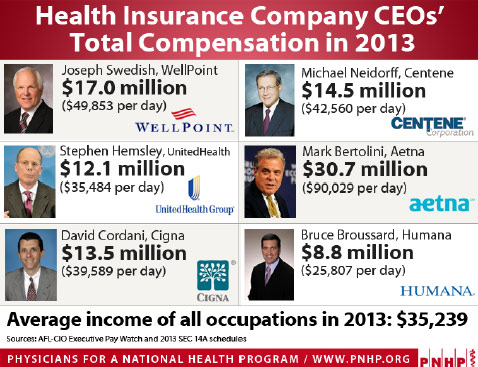
My Take On...
How Hospitals, Drug Makers, And Medical Device Firms Gouge Patients
-- The following is reprinted from the Spring 2013 Newsletter of Physicians for a National Health Program (PNHP).
-- Time magazine recently published a scathing critique of the health care system by Steven Brill. Among the interesting facts he presented:
-- Pharmaceutical, insurance and other health care industries have spent $5.36 billion since 1998 on lobbying in D.C. In comparison, the defense and aerospace industries spent $1.53 billion and the oil and gas industry spent $1.3 billion during the same period.
-- The typical new cancer drug coming on the market a decade ago cost about $4,500 per month (in 2012 dollars) but since 2010, the median price has been around $10,000. Two new cancer drugs cost more than $35,000 each per month. - Drug and device makers mark up their products dramatically for sale to hospitals. The hospitals, including nonprofits, turn around and mark them up again with different prices for Medicare, private insurers, and patients. The resulting price gouging can be astonishing. Genentech can make its cancer drug Rituxan for as little as $300 a dose, but sells it to hospitals for about $3,500 a dose, who may then charge patients more than $13,000.
-- Some of the biggest profits are on devices. Medtronic can make a neurostimulator for $4,500 and sell it to a hospital for $19,000, for a gross profit of $14,500 before overhead. The hospital may then charge the patient $49,237.
-- Aetna spent $6.9 billion on operating expenses in 2012, about 29 percent of the $23.7 billion the firm paid out in claims. Medicare is very administratively efficient, spending just 1.4 percent of its budget on overhead.
-- Many nonprofit hospitals have become hugely profitable. MD Anderson Cancer Center, a nonprofit unit of the University of Texas, had an operating profit of $531 million on revenues of $2.05 billion, for a profit margin of 26 percent in 2011. Montefiore Medical Center in New York had operating profits of $196.8 million on $2,586 billion in revenue, for a profit margin of 8 percent (Steven Brill, “Bitter Pill: Why medical bills are killing us,” Time, 2/20/13).
Reprinted with permission.

© Copyright 2013 - 2018 by Pat Hennessy MD MPH Design by Victoria Young Maciulski